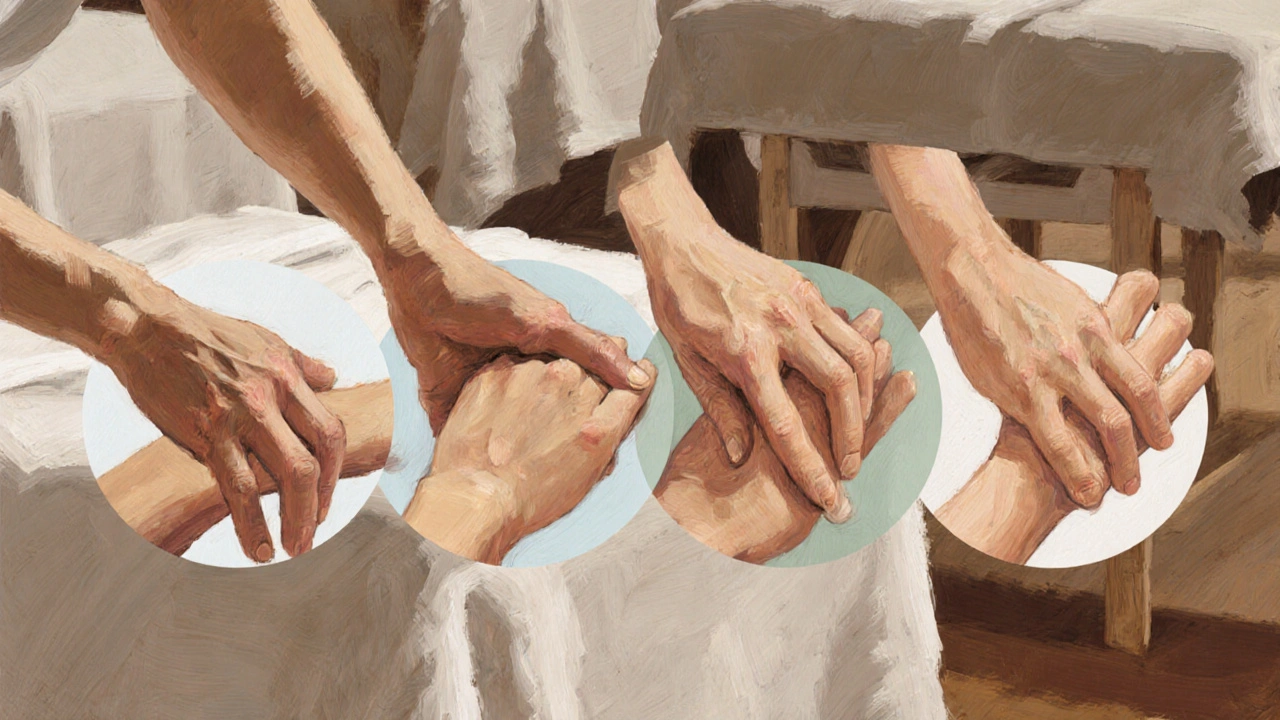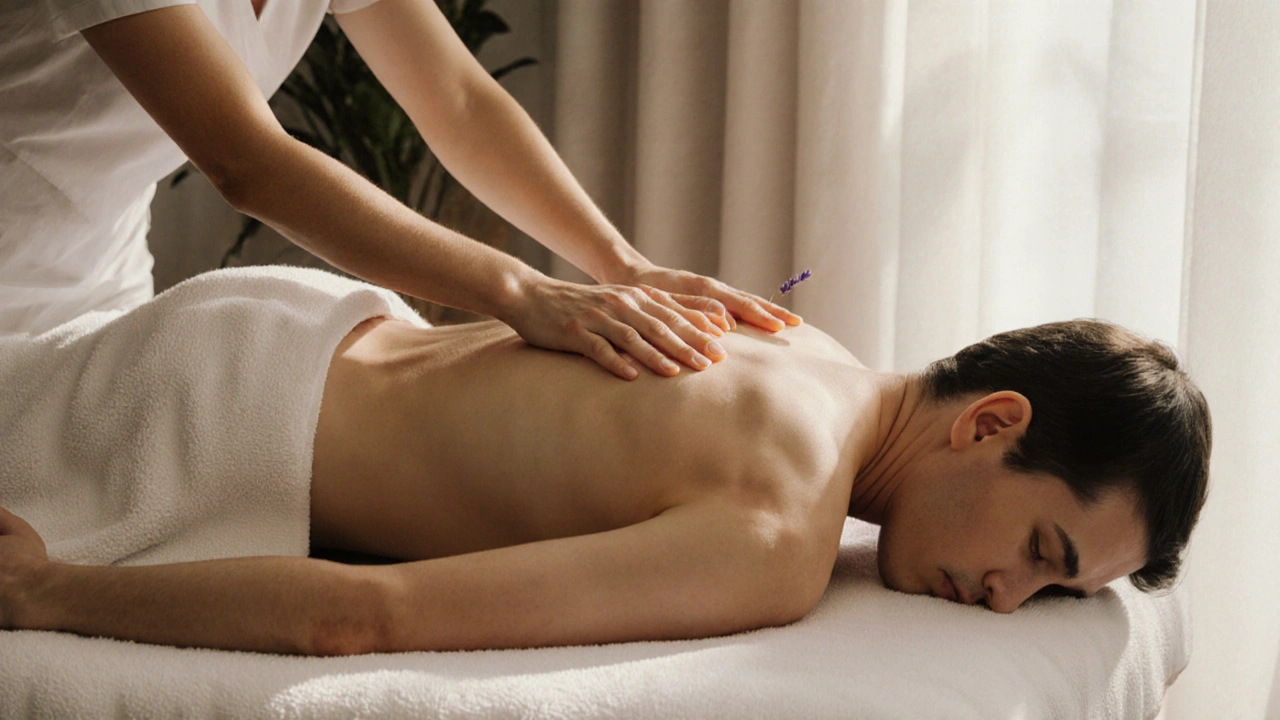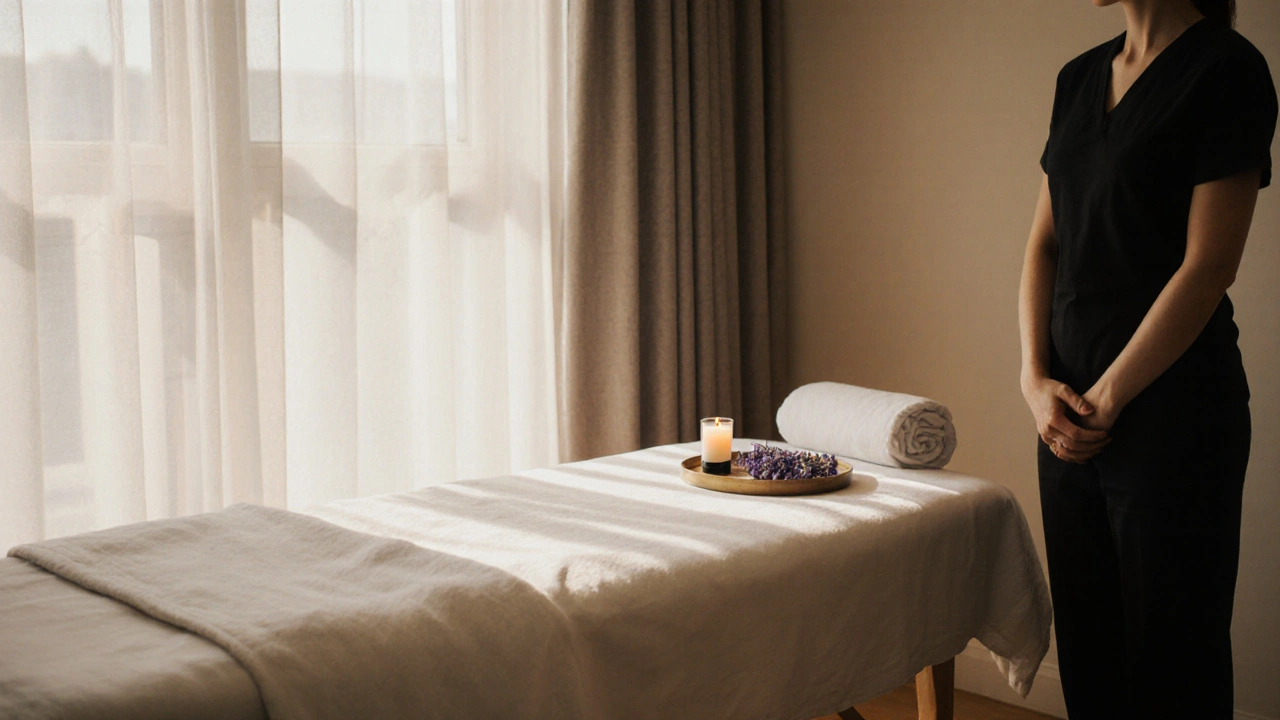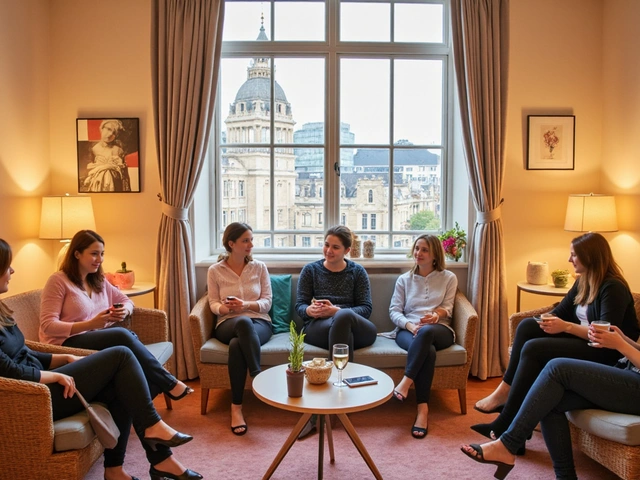You’ve had a long week. Your shoulders are tight, your mind won’t shut off, and you just want to feel like yourself again. What if you could melt into calm without drugs, without screens, without even saying a word? That’s the quiet power of Swedish massage.
What Is Swedish Massage, Really?
Swedish massage isn’t fancy. It doesn’t use hot stones, essential oils in neon bottles, or chanting. It’s simple. It’s slow. It’s built on five core movements: effleurage (gliding strokes), petrissage (kneading), friction (deep circular pressure), tapotement (rhythmic tapping), and vibration. These aren’t random motions-they’re designed to calm your nervous system, not overwhelm it.
It was developed in the 1800s by a Swedish physiotherapist named Per Henrik Ling. He didn’t set out to create a spa trend-he wanted to help people move better and feel less pain. Today, it’s the most common type of massage in the UK, not because it’s trendy, but because it just works.
Think of it like a gentle reset button for your body. No deep tissue tearing. No pressure that makes you wince. Just steady, flowing touch that tells your muscles: it’s safe to relax now.
Why Swedish Massage Works When Nothing Else Does
Here’s what happens when you lie on the table:
- Your heart rate slows down-studies show it can drop by 10-15 beats per minute after just 30 minutes.
- Cortisol, your main stress hormone, drops by up to 31%, according to research from the University of Miami.
- Endorphins rise. Not just a little-enough to give you that warm, slightly dizzy glow you get after a good walk in the sun.
- Your circulation improves. Blood flows more easily to tired muscles, flushing out lactic acid and other waste that builds up from sitting at a desk all day.
One client in Brighton told me, "I’ve tried yoga, meditation, even CBD gummies. Nothing quieted my brain like a 60-minute Swedish massage." That’s not magic. That’s physiology.
It’s not just for people who sit at computers. Parents of toddlers, nurses on night shifts, delivery drivers, teachers-anyone carrying invisible weight finds relief here.
Swedish Massage vs. Other Types: What Sets It Apart
Let’s cut through the noise. You’ve heard of deep tissue, Thai, sports massage. What makes Swedish different?
| Feature | Swedish Massage | Deep Tissue | Thai Massage | Hot Stone |
|---|---|---|---|---|
| Pressure Level | Light to medium | Heavy, focused | Variable, includes stretching | Medium, warmed stones |
| Goal | Relaxation, circulation | Release chronic tension | Energy flow, flexibility | Deep warmth, muscle release |
| Use of Oil | Yes, lots | Yes, but less | No, clothing stays on | Yes, with stones |
| Best For | Stress relief, beginners | Chronic pain, athletes | Flexibility, energy blocks | Cold muscles, arthritis |
| After Effects | Calmer, lighter, clearer mind | Soreness, then relief | Invigorated, sometimes tired | Deep warmth, very relaxed |
Swedish massage is the gateway. It’s the one you try when you’re not sure what you need. It’s the one you come back to when you just need to breathe again.

What Happens During a Session?
You walk into a quiet room. Soft lighting. The scent of lavender or nothing at all-just clean sheets and warm towels. The therapist asks if you’re comfortable with pressure. You say yes. Then you lie down, covered in a towel, and they leave the room.
When they return, their hands are warm. They start with your back-long, smooth strokes from your neck down to your lower back. It’s not rushed. Each stroke lasts 5-7 seconds. They don’t dig in. They don’t crack anything. They just… glide.
Then comes the kneading-gentle circles around your shoulders, like someone is slowly working dough. Your arms feel heavy. Your jaw unclenches. You forget why you were stressed in the first place.
They move to your legs. A little pressure on your calves. A slow roll along your thighs. Your breathing deepens. You might drift off. That’s normal. That’s the point.
At the end, they give you a moment. No rush. No "you’re done!" Just silence, and the quiet sound of your own breath.
You sit up slowly. You feel… lighter. Not just physically. Mentally too. Like someone took a damp cloth and wiped the static off your mind.
Where to Find a Great Swedish Massage in Brighton
Brighton has no shortage of massage places. But not all are created equal. Here’s what to look for:
- Therapist qualifications: Look for someone registered with the Complementary and Natural Healthcare Council (CNHC) or the Federation of Holistic Therapists (FHT). These aren’t just fancy titles-they mean they’ve passed safety and ethics checks.
- Environment: A good place feels calm, not corporate. Think candles, not fluorescent lights. Soft music, not a playlist of pop hits.
- Communication: They should ask about your goals. "Just relax?" is a valid answer. No pressure to sign up for a package.
- Location: Try The Body Works in Kemptown, or The Spa at The Grand on the seafront. Both have strong reviews for Swedish massage and a real focus on relaxation, not sales.
Don’t be afraid to call ahead. Ask: "Do you specialize in Swedish massage?" If they say "We do all kinds," that’s fine. But if they hesitate or start pitching a 10-session bundle, walk away.
How Much Does It Cost?
Prices in Brighton vary, but here’s the real breakdown:
- 60 minutes: £55-£75
- 90 minutes: £80-£105
- 120 minutes: £110-£140
That’s more than a coffee. But less than a movie ticket and takeaway dinner. And unlike those, the effects last days.
Some places offer first-time discounts-around £10 off. Others have loyalty cards: buy 5 sessions, get the 6th free. Worth asking.
Book online. Most studios let you pick your time, therapist, and even music preference. No phone tag. No awkward small talk.

What to Do Before and After
Before your session:
- Drink water. Not a bottle-just a glass. Hydration helps your muscles respond better.
- Don’t eat a heavy meal 2 hours before.
- Wear loose clothes to the studio. You’ll change into a towel anyway, but comfort helps you settle in.
After your session:
- Drink more water. Your body is flushing out toxins. You’ll feel better faster if you hydrate.
- Don’t rush. Sit quietly for 10 minutes. Scroll less. Breathe more.
- Give yourself the rest of the day. Don’t plan a workout or a big meeting. Let the calm stick.
Some people feel a little tired. That’s normal. It’s not a hangover-it’s your body catching up on rest.
Who Should Avoid Swedish Massage?
It’s safe for almost everyone. But skip it if:
- You have a fever or infection.
- You’ve had a recent injury or surgery (wait at least 2 weeks).
- You have open wounds, severe bruising, or blood clots.
- You’re in the first trimester of pregnancy-unless you’re seeing a therapist trained in prenatal massage.
Always tell your therapist about any health conditions. Even if you think it’s not important. They’ve seen it all.
Frequently Asked Questions
Is Swedish massage the same as relaxation massage?
Yes, essentially. "Relaxation massage" is often just another name for Swedish massage, especially in spas. Both focus on gentle, flowing strokes to reduce stress. The difference is mostly in marketing-not technique.
Do I have to take my clothes off?
You can keep your underwear on. Most people do. The therapist will drape you with towels so only the area being worked on is exposed. You’re never uncomfortable. Your privacy is always respected.
Can I talk during the massage?
You can, but you don’t have to. Some people like to chat. Others fall asleep. Both are fine. The therapist will follow your lead. If you’re quiet, they’ll stay quiet too.
How often should I get a Swedish massage?
Once a month is ideal for stress management. If you’re dealing with high stress, try every 2 weeks for a few months, then drop to monthly. It’s not a cure-all-but it’s one of the most reliable tools you can use.
Is Swedish massage good for anxiety?
Yes. Studies show regular massage reduces symptoms of anxiety by lowering cortisol and boosting serotonin. It doesn’t replace therapy, but it gives your nervous system a break from constant alert mode. Many therapists in Brighton work with clients managing anxiety and tailor sessions to be extra calming.
Ready to feel the weight lift? Book your session. Not tomorrow. Not next week. Today. Your body’s been waiting.









David Perz
November 10, 2025 AT 00:13Swedish massage is basically the OG of relaxation techniques. I’ve tried deep tissue, hot stone, even reflexology-nothing sticks like this. The key is the rhythm. It’s not about pain or pressure; it’s about rhythm. Your nervous system doesn’t fight it. It just… gives in. I’ve been doing it monthly for three years now. My anxiety? Down 70%. My sleep? Unbroken. And no, I don’t take melatonin anymore.
Nicholas F
November 10, 2025 AT 23:43Let’s be real-this is just fancy touchy-feely nonsense wrapped in pseudoscientific jargon. You’re telling me that gliding your hands over my back is better than a good cry, a stiff drink, or just… sitting in silence? I mean, come on. We’ve got quantum physics and AI, and we’re still paying $75 to be rubbed like a cat? This is what happens when capitalism turns spirituality into a subscription service.
Autumn Grace
November 12, 2025 AT 16:51Oh honey, Nicholas, you’re such a drama llama. 😂 I got my first Swedish massage after my divorce-sobbing into the face cradle, fully clothed, and the therapist just kept going like, ‘You good?’ I said no. She kept going. I said yes. She kept going. By the end? I didn’t cry. I just… breathed. And now I bring my mom. And my dog’s therapist. And my ex’s new girlfriend. (No, not really.) But seriously-this isn’t magic. It’s just permission. Permission to stop fighting your own body.
Laura Szabó
November 12, 2025 AT 18:15I work in ER. Sixteen-hour shifts. Three days on, two off. I used to come home and just collapse. Then I started getting Swedish massages every other week. Not because I wanted to, but because my partner made me. I thought it was a waste of money. Now? I don’t even think about it. My hands don’t shake anymore after a night shift. My shoulders don’t feel like they’re holding up the ceiling. I don’t need to explain it. I just know.
Carl Grann
November 13, 2025 AT 05:24Let’s dissect this ‘physiology’ nonsense. You cite a University of Miami study-great. But what’s the sample size? Were they double-blind? Was there a control group? Or did they just hand out massages to 12 stressed-out grad students and call it science? And cortisol drops by 31%? That’s a huge number. Where’s the peer-reviewed paper? Also-why is ‘lavender’ always the scent? Is that a cultural placebo? And why does everyone assume this works for ‘parents of toddlers’? I’ve seen moms who come out of these sessions and immediately yell at their kids for spilling juice. The massage didn’t fix the parenting-it just delayed the explosion.
Colleen McGhan-Cox
November 13, 2025 AT 08:02Carl, your skepticism is so last decade. 🙄 The science is solid-multiple meta-analyses in JAMA, the Journal of Clinical Psychiatry, and the British Journal of Sports Medicine confirm the neuroendocrine shifts. And yes, the lavender? It’s not placebo-it’s olfactory limbic modulation. You’re literally triggering the amygdala’s calming cascade. Also-your ‘parent yelling’ example? That’s not a failure of massage-it’s a failure of integration. The point isn’t to magically fix your life-it’s to give your nervous system the bandwidth to *choose* better responses. You’re not fixing the kid-you’re fixing the parent’s capacity to *hold space*. And if you can’t see that, maybe you need a session yourself. No shame. Just science.